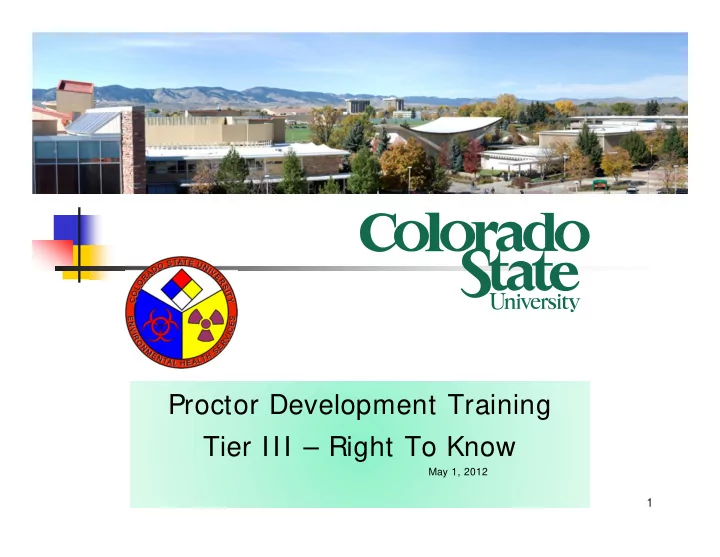

Proctor Development Training Tier III – Right To Know May 1, 2012 1
HAZARDS COMMUNICATION STANDARD (August, 2008) Employees Must be informed of hazards in the workplace Chemical manufacturers Identify all physical and health hazards Attaching warning labels to each container Send an accurate MSDS (Material Safety Data Sheets) to any company to whom the material is shipped 2
HAZARDS COMMUNICATION IS A RESPONSIBILITY OF ALL Everyone should be aware of chemicals and other hazardous materials and conditions. EHS keeps all the MSDS’s in database Supervisors must see that all workers are aware of safety standards 3
Your Responsibilities: Read all instructions on the each product warning labels (WATER has an MSDS!) Where to go if you have Questions The Container label Supervisor MSDS EHS 4
Your Responsibilities: ABOVE ALL - Use your common sense and protect yourself and others ! Be available to responders Be a good resource 5
EHS Responsibilities: Keep all MSDS in database Training Provide Information / MSDS on chemicals Provide guidance to all safety related topics 6
Physical Hazards Act outside the body to produce a dangerous situation. Examples: Vehicle accidents Mechanical Boilers, Steam vents Fire: Gasoline, Hexane, and Methanol… Explosions: TNT, Picric acid … Falls: Trip, Ladder, and Steps… Sharps: Knifes, Glass, and Jagged Metal… 7
Health Hazards: Cause damage within the body Examples: Lung Damage: Corrosive Fumes, Asbestos… Poisoning: Eating, or Absorbing Toxic substances (recent cases: Harvard coffee in lab, child licking hand sanitizer) 8
Hazards of chemicals: Can pose Physical Hazards or Health Hazards or Both. Chemicals are Found: Home Vehicles Job Almost Everywhere 9
Chemical hazards at CSU: Everywhere, not just your building Nearly all jobs at CSU have both Physical and Chemical Hazards 10
General types of chemical hazards: Flammable: Methanol, Gasoline, Hexane Corrosive: Hydrochloric acid, Sodium Hydroxide Toxic: Cyanide, Pesticides, Mercury Oxidizers: Bleach, Perchloric and Chromic acids Water Reactive: Pure Sodium, Magnesium Perchlorate Explosives: Trinitrotoluene (TNT), Picric acid 11
Container Labeling All chemicals, and chemical wastes must be properly labeled* and marked. Notify EHS if you find unmarked containers * Contact EHS for requirements 12
Building and Room postings University wide program for consistent labeling Notify EHS for postings 13
NFPA Laboratory Placarding 4 = Severe Hazard 3 = Serious Hazard 2 = Moderate Hazard 1 = Slight Hazard 0 = Minimal Hazard NFPA 704 Hazard Placard 14
Your Questions? Discussion about issues you’ve identified Share your expertise with others! 15
Resources www.epa.gov/emergencies/content/epcra/index.htm www.ehs.colostate.edu www.training.colostate.edu/proctor/index.html
Recommend
More recommend